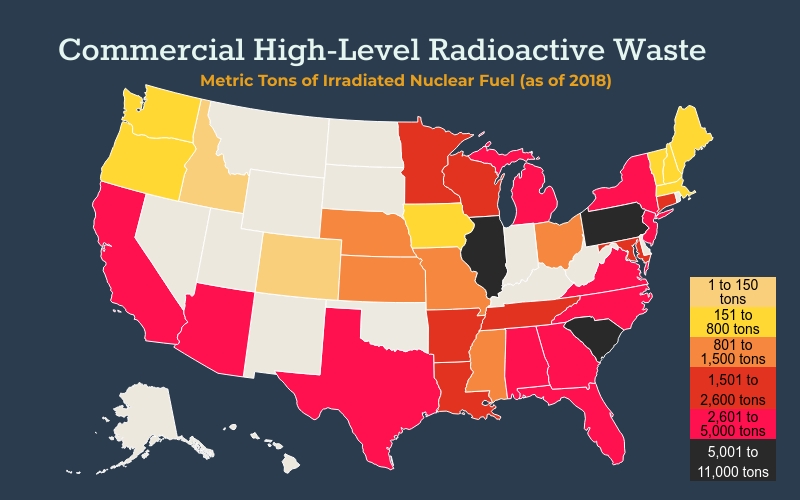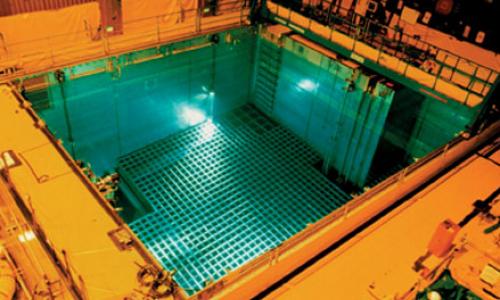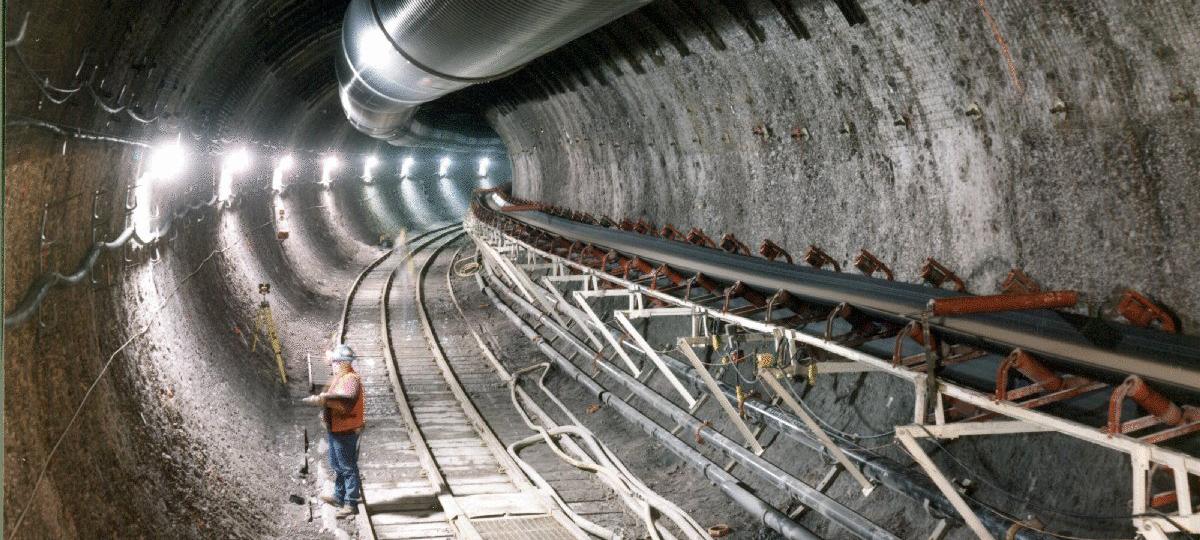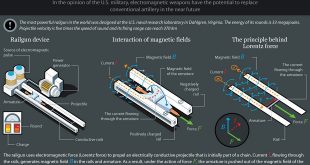Nuclear power—with its high energy density and low carbon footprint—is a source with which the international community has decades of experience. However, the challenges that come along with the technology have kept it from becoming a more dominant factor in the global energy mix. Geopolitical issues lie at the center of many of these challenges. Matters of safety, waste management, and proliferation are intrinsic to the technology. Although the carbon footprint of using nuclear fuels is smaller, there are still disadvantages of using nuclear fuel. Nuclear fuels require far more complicated systems to extract their energy, which calls for greater regulation.
The challenge of making nuclear power safer doesn’t end after the power has been generated. Nuclear fuel remains dangerously radioactive for thousands of years after it is no longer useful in a commercial reactor. The resulting waste disposal problem has become a major challenge for policymakers. The waste, while a much lower volume must be handled very carefully because of its radioactivity.
In Europe alone, there are at least 60,000 tonnes of highly radioactive spent fuel rods and another 2.5 million cubic metres of low- and intermediate-level waste waiting for an adequate storing facility, says the report that focussed on European countries (excluding Russia and Slovakia due to incompatible databases) and the US.
Highly radioactive waste, often called high-level waste, comes mainly in two forms. One is leftover fuels that were used in nuclear power plants to generate electricity. The other is the waste made by facilities involved in nuclear weapons production or by facilities that reprocess and recycle used power plant fuel.
Regardless of whether you are for or against nuclear power, and no matter what you think of nuclear weapons, the radioactive waste is already here, and we have to deal with it’s matter-of-fact take on the thousands of metric tons of used solid fuel from nuclear power plants worldwide and the millions of liters of radioactive liquid waste from weapons production that sit in temporary storage containers in the US, said Gerald S. Frankel. While these waste materials, which can be harmful to human health and the environment, wait for a more permanent home, their containers age. In some cases, the aging containers have already begun leaking their toxic contents. “It’s a societal problem that has been handed down to us from our parents’ generation,” says Frankel, who is a materials scientist at the Ohio State University. “And we are—more or less—handing it to our children.”
Some experts cite reprocessing as a partial solution to the nuclear waste issue. Reprocessing separates nuclear waste into component materials, including plutonium, which can then be re-used as nuclear reactor fuel—but also as the raw material for a nuclear weapon. Union of Concerned Scientists (UCS) opposes reprocessing because it increases proliferation and terrorism risks while actually adding to the waste problem rather than reducing it. The United States has chosen to dispose of the spent fuel at this point because reprocessing—that is, separating the recyclable elements such as plutonium from the rest—is considered to pose an unacceptable proliferation risk. It also considers recycling to be uneconomical.
Russia has taken a very different approach to managing spent fuel and nuclear waste. It considers spent fuel as a valuable energy resource because typical reactor operations today consume less than 1 percent of the available energy of the uranium fuel before it has to be removed from the reactor. Russia, on the other hand, views spent fuel to be a valuable energy resource, particularly if the recovered plutonium is used for fuel in fast reactors. It also believes that the proliferation risks of reprocessing are manageable. These views are shared by the French government, which has recycled its spent fuel for many years.

Nuclear Storage Solutions
As of December 2013, the International Atomic Energy Agency (IAEA) reports an estimated 250,000 tons heavy metal of spent fuel in storage worldwide and 120,000 tons of heavy metal of reprocessed spent fuel. Of the solid nuclear waste resulting from nuclear operations, more than 98 percent is classified as being very-low- or low-level waste in volume terms, with most of the remainder being intermediate-level waste, all of which can be disposed safely.
Spent nuclear fuel and high-level waste are the most problematic in that they require isolation and permanent disposal, but they are currently in interim storage because no permanent solutions have been implemented. Such storage sites include containment pools at the reactor plant for spent fuel until it has cooled (both thermally and radioactively) for several years followed by storage in dry casks for a relatively long-term (perhaps on the order of a century, but explicitly not permanent).
Spent fuel pools at nuclear power plants, intended to house nuclear waste only until it is cool enough to be transferred to permanent storage, have become dangerously overcrowded as the search for a permanent repository has stalled. UCS experts are recommending that spent fuel should be transferred to dry casks as soon as possible to reduce this safety hazard.

About a dozen countries, including Finland, Switzerland, and other European nations, are planning deep geological repositories for their nuclear waste. In the US, government officials have proposed storing the country’s waste in a repository beneath Yucca Mountain in Nevada. The site lies about 300 m below ground level and 300 m above the water table. But the Yucca Mountain site has gone in and out of favor with changes in the US’s leadership.

The challenge of finding and funding a final repository for radioactive nuclear waste has not been solved by any of the countries employing nuclear power in Europe or the rest of the world, the “World Nuclear Waste Report” compiled by the Green Party-affiliated Heinrich-Böll-Foundation in Germany has found.
Germany has decided to end the use of nuclear power by 2022 and initiated a search for a final repository that is meant to be completed by 2031. It has set up a managed fund that is supposed to multiply the value of its assets from 24 to about 170 billion euros by the end of the century to cover the costs of setting up a final repository. The dismantling of nuclear plants is expected to generate contaminated waste in Germany until the 2040s but there has also been controversy over exports of nuclear material from other sources to Russia, which had been labelled as “recyclable material” but according to critics amounts to nothing more than “cheap dumping” of waste.
It found that at the same time governments are still underestimating the costs of disposing of this waste and thus lack proper financing models, meaning that taxpayers ultimately might have to foot the “massive” bills that could arise at some point in the future, the report says. Marcos Buser, Swiss geologist and co-author of the report, said interim storage facilities currently used to shelve the waste have not been designed for long-term use and are reaching their capacity limits. “The shutdown and decommissioning of many nuclear power plants will again drastically increase the quantities,” Buser warned, adding that almost all major nuclear power using countries in the world “are kicking the can down the road” and treat the existing risk with much less urgency than it deserves.
Technology Solutions
A number of permanent nuclear waste disposal options (as summarized by the World Nuclear Association) have been proposed over time, including disposal at sea, disposal in subduction zones, disposal in outer space, and disposal by deep well injection. However, all of these options have been scrapped because they were deemed impractical, not economical, unsafe, environmentally destructive, or in violation of international agreements. The development of deep geological repositories is currently the favored long-term solution among developed nations with civilian nuclear programs.
Vitrification
One way that scientists have come up with to store liquid nuclear waste more permanently is to vitrify it. In this process, the hazardous material is converted to a more easily managed immobile solid—glass. Not only does glass prevent toxic species from leaking into the environment, but it also provides some shielding against radioactivity leakage and is highly durable.
For years, India, France, the UK, and other countries have carried out vitrification of liquid waste from weapons production and fuel recycling—and still do. In the US, operators at Savannah River have been vitrifying weapons-related waste for about 20 years. And although the US does not currently recycle fuel, it did so in the 1960s and ’70s near Buffalo, New York, in a program known as the West Valley Demonstration Project. The operation generated 275 canisters of glass from vitrifying high-level waste; the canisters are stored there and await permanent disposal in a repository.
Vitrification process involves blending waste materials with glass precursors, heating the mixture to above 1,000 °C to melt the components, pouring the molten glass into a storage container, and letting it cool and solidify, locking the harmful constituents in the glass matrix.
“Vitrification of nuclear waste seems to be well established by now, but actually it still faces complex problems,” says Ashutosh Goel, a materials scientist at Rutgers University. The plan at Hanford, for example, calls for entombing nuclear waste in borosilicate glass and encasing the glass in stainless-steel canisters. Yet the exact formulation of the glass, or glasses, is still under investigation.
After 1,000 years or so, Goel says, the steel canister surrounding the glass will likely corrode, and groundwater may seep in and interact directly with the glass, degrading it. “The stability of the glass in the presence of groundwater represents the last line of defense against release of radionuclides” into our environment, he adds.

Scientists are studying glass samples to understand long-term corrosion of vitrified nuclear waste. These micrographs show the results of accelerated aging tests on two types of aluminosilicate glasses. Ions have leached from the glasses and crystallized on their surfaces: the largest of these false-color crystals (yellow on left, pale blue on right) are sodium aluminum silicate hydrates of various composition and structure.
Researcher Developing Novel System For Nuclear Waste Repositories
A Texas A&M professor, in collaboration with the University of Nebraska-Lincoln, received a Department of Energy grant to develop a system in engineered barriers to isolate and contain nuclear fuel waste. Nuclear power plants have supplied about 20% of the United States’ annual electricity generation since 1990, according to the U.S. Energy Information Administration. But that energy creates high-level radioactive waste that has to be stored.
Yong-Rak Kim, professor in the Zachry Department of Civil and Environmental Engineering at Texas A&M University, has been awarded a U.S. Department of Energy Nuclear Energy University Program grant to develop a novel system in engineered barriers to permanently isolate and contain nuclear fuel waste. Kim is collaborating with researchers from Sandia National Laboratories and the University of Nebraska-Lincoln. “We need to find a way to store nuclear fuel waste for a long time in a very safe manner. This is a huge challenge for many countries where nuclear power plants have been operated,” Kim said. “We need to find a better material that is less permeable and more resistant to cracking and chemical degradation than conventional materials in challenging geological environments.”
All of the nuclear waste that a power plant generates in its entire lifetime is currently stored on-site in dry casks, which is a temporary solution for nuclear waste disposal. “The fundamental understanding and resulting novel material will vastly improve nuclear waste management and support the enhanced safety and security of nuclear-generated electricity in the United States,” Kim said. The new engineered barrier material reinforced by inorganic microfibers will significantly reduce the threat from the long-term disposal of spent nuclear fuel. This will enable sustainable nuclear energy cycles in the United States. “We are very excited to be working on this project,” Kim said. “The impact is huge as we can better engineer the nation’s nuclear waste management more safely for the next several centuries. It is also a great opportunity to work with the Department of Energy National Laboratories and Technology Centers.”
Radiation-eating bacteria could make nuclear waste safer
Certain microbes can use radionuclides such as uranium and neptunium in place of oxygen, studies have found. In doing so, they convert them from soluble to insoluble forms, making them less mobile. This should give us more confidence in waste disposal plans, says Jonathan Lloyd, a geomicrobiologist at the University of Manchester, UK, who presented the research at the annual meeting of the Microbiology Society in Edinburgh in 2017.
The radiation levels typically found at nuclear waste dumps don’t seem to pose a problem for bacteria either. “It doesn’t kill them,” says Lloyd. “If anything, it actually stimulates the microbes.” The study found that the way bacteria process waste products means hazardous material is less likely to seep into the environment. Some nuclear waste contains cellulose, which can break down to form isosaccharinic acid (ISA) under alkaline conditions. ISA can form a soluble complex with uranium, helping it to leak out of the waste repository. But bacteria seem to use ISA as a carbon source and degrade it, keeping radionuclides in solid form – which means they stay in place.
Microbes may also help prevent radioactive gases escaping. Hydrogen produced by reactions in the repositories could build up pressure and cause them to crack open or explode. But microbes can us e hydrogen and keep the levels down. They can also grow in fractures in the rock, form biofilms and clog up pores. “At the moment, they have safety case models that are built on chemistry and physical containment. If you start including the biology, it means that those models are actually overly conservative, which is a good thing,” says Lloyd.
Diamond Battery
One of the solutions to Nuclear waste is an atomic battery, nuclear battery, radioisotope battery or radioisotope generator is a device which uses energy from the decay of a radioactive isotope to generate electricity. Like nuclear reactors, they generate electricity from nuclear energy, but differ in that they do not use a chain reaction. Although commonly called batteries, they are technically not electrochemical and cannot be charged or recharged. In comparison they are very costly, but have an extremely long life and high energy density, and so they are mainly used as power sources for equipment that must operate unattended for long periods of time, such as spacecraft, pacemakers, underwater systems and automated scientific stations in remote parts of the world.
References and Resources also include:
https://cen.acs.org/environment/pollution/nuclear-waste-pilesscientists-seek-best/98/i12
 International Defense Security & Technology Your trusted Source for News, Research and Analysis
International Defense Security & Technology Your trusted Source for News, Research and Analysis


